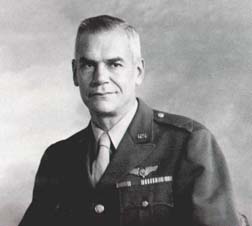

Samuel Gibson
Frantz was born on March 15, 1897 in Duluth, Minnesota to Mary Katherine
(Gibson) Frantz, wife of Alfred Jacob Frantz. Following his father's
death in 1905 the family moved to Edinburgh, Scotland, and Frantz entered
the Edinburgh Academy where he consistently achieved grades near the
top of his class, and was outstanding in Latin and Mathematics.
The family
returned to the United States in 1910 and resided in Princeton, New
Jersey. Frantz entered The Lawrenceville School nearby, from which he
graduated in 1913. He entered Princeton University as a member of the
class of 1918 at the age of 16, but left shortly after the beginning
of World War I to serve as an ambulance driver with the American Field
Service in France. He also served in the U.S. Air Service (Aero) of
the Army as a balloonist and aerial observer in France. Frantz was discharged
as a second lieutenant at the end of the war.
Reentering
Princeton, Frantz graduated in 1919 with a degree in civil engineering
and membership in the honorary societies Phi Beta Kappa and Sigma Xi.
He married
Sarah Wistar Morton in 1921 and during the following decade, Frantz
did several kinds of engineering work, including some municipal civil
engineering as an independent contractor. In 1923 he obtained the Master
of Science degree in Physics from Princeton University. Beginning in
the same year he studied at the Ecole Supérieure d' Electricité of the
Sorbonne in France. By 1932 he was well advanced in the field that was
to be his life's work. He co-authored a paper that year which was delivered
at a meeting of the American Institute of Mining and Metallurgical Engineers.
It described the induced roll separator invented in 1926 by Fred R.
Johnson of the Exolon Co., which at the time was considered a major
step forward in the technology. It expressed the view that . . . research
both in the design of machines and in their applications will continue
in the next five years as rapidly as it has in the last five years and
make the magnetic method one of the most important tools in ore dressing.
Frantz founded
S.G. Frantz Company in 1935 to manufacture products embodying his inventions,
and started operations in a loft in New York City. The patent in which
he disclosed the principles of design governing sensitive separation
according to susceptibility (US #2,056,426) was issued to him the following
year. In the ensuing years he received a total of four more patents:
1937 –
for a separator consisting of an iron jacketed solenoid with a filamentary
matrix in the bore of the solenoid, principles of design which today
govern separators for magnetic filtration of materials (US #2,074,085)
1943 –
for a separator for magnetic filtration of dry materials (US #2,331,769)
1950 –
for a separator for magnetic filtration of wet materials with oppositely
polarized permanent magnets above and below a filamentary matrix (US
#2,508,666)
1965 –
for a device employing oppositely polarized permanent magnets for
magnetizing a matrix that performs a straining function as well as
magnetic separation (US #3,221,882)
Except for
a hiatus from 1943 to 1944 when he served as Chief of the Operations
Analysis Section of the Ninth Air Force in Benghazi, Libya (where he,
with his group, developed a manual which became the official training
booklet for aerial machine gunnery throughout the Air Force) and later
in Tunisia and Bari, Italy with the XII Bomber Command (which became
the Fifteenth Air Force), Frantz devoted the rest of his life to the
processes he was inventing. In 1950 he moved the base of operations
to Lawrenceville, New Jersey, where the company still manufactures separators
of superior quality and design. He died in 1971.
|